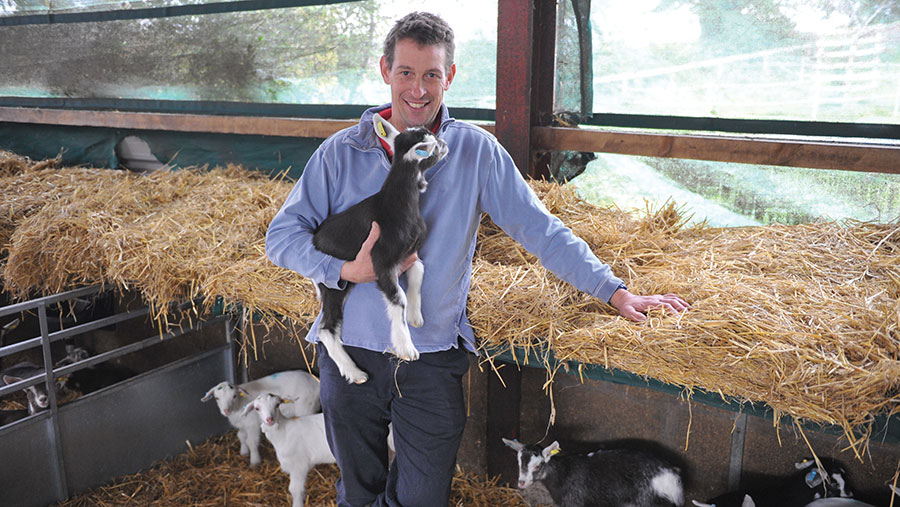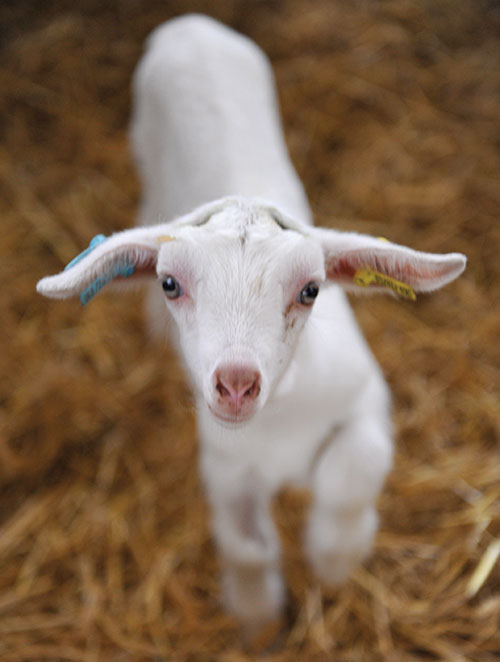How a goat farmer has lifted AI conception rates
 Gary Yeomans © Debbie James/Ma Agriculture
Gary Yeomans © Debbie James/Ma Agriculture A dairy goat farmer has increased conception rates by 10% after switching from natural service to a synchronisation and artificial insemination (AI) breeding programme.
Gary Yeomans, who farms with his wife, Jess, at Pant Farm, Monmouthshire, has seen conception rates increase from 38% in 2019 to 48% after adopting the programme on some of his 600 dairy goats.
See also: Zero grazing helps dairy goat farmer to reduce concentrates
He initially used sponges, but changed to now use controlled internal drug-release dispensers (CIDRs), as there is less fluid created after removal, which can make AI more difficult.
Although synchronisation is expensive – costing about £9 a goat – he believes it is money well spent due to the improved fertility, increased genetic gain, as well as reducing the risk of disease from bought-in males.
Farm facts
- 115ha farmed, 6ha owned, remainder rented, contract or share-farmed
- 24ha maize, 20ha winter wheat and winter oats and 6ha wholecrop grown
- Milking 600 British Saanen goats
- Yields 184 litres a goat a year
- Milk sold to Abergavenny Fine Foods
Imported semen
Mr Yeomans is using is using goat semen from France and Holland because of the extensive progeny testing undertaken in those countries.
There is also good knowledge of the breeding values and a diversity of bloodlines, with selection available on milk, components and type.
He opts for sires in the mid-price range, paying £11-£23 a straw. Billy goats are introduced 15 days after AI to catch any repeats.
Benefits of AI
There are multiple benefits to DIY AI, he says. “The goats are used to us, so it provides a calmer atmosphere for them than when the vet would come here to do it.”
The first kids from the 30 females mated in 2019 using AI were born on 26 February. “They are big, strong kids,” Mr Yeomans reports.
He is now planning to increase numbers mated through AI – he will inseminate 60 over two days. “We want the autumn kidders to kid in the first week of September, so we will put the CIDRs in at the end of March.”
Mr Yeomans hopes using good genetics will help him increase milk yields, much like the progress that has been made in the dairy industry.
Step-by-step guide to performing DIY AI in dairy goats
AI with visual heat detection only is “hit and miss’’ and is mostly only used in organic farming situations where breeding hormones cannot be used, says Mr Yeomans.
In this case, he says, females should be inseminated twice at 12-hour intervals.
Below, Mr Yeomans talks us through a step-by-step guide to AI insemination.

Saanen kid © Debbie James/Ma Agriculture
Preparation
-
Before the female is restrained, thaw the semen according to the supply company’s recommendations – remove the straw from the liquid nitrogen tank with the straw tweezers and place it in a thaw box filled with warm water for 30 seconds.
-
Restrain the female. A breeding stand can be used so one person can restrain the goat, but if not available, two people are needed – one on each side of the goat, to lift her hind legs so the AI operator can do the insemination while she is standing only on her front legs.
-
Prepare the insemination gun.
-
After thawing, dry the straw thoroughly with a paper towel.
Semen must be kept warm and must not be exposed to sunlight or water during the thawing and insemination process to prevent damaging or killing sperm cells. -
Pull the plunger back 10-15cm on the insemination gun and place the straw into the gun, with the cotton plug towards the plunger.
-
After the straw has been secured in the gun, the sealed end of the straw must be cut off with the straw cutter.
-
The cover sheath should now be placed over the insemination gun and secured with an O-ring.
-
Keep the straw warm by placing the gun down your back.
Insemination
-
Lift the doe’s hindquarters.
-
Lubricate the speculum with a non-spermicidal lubricant.
-
Clean the doe’s vulva with a dry paper towel and insert the lubricated speculum slowly into the vulva, at an upward angle to prevent vaginal irritation.
-
Once the speculum has been inserted, locate the cervix.
-
Centre the speculum over the opening of the cervix.
-
Insert the insemination gun into the speculum and thread it into the opening of the cervix.
-
Use a circular motion and slight pressure to work the insemination gun through the rings of the cervix.
-
Do not penetrate the cervix any deeper than 3.5cm – as a guide, draw a ring around the cover sheath of the insemination gun 3.5cm from the tip, to let you know how far you have penetrated the cervix.
-
Deposit the semen slowly by pushing the plunger forward.
-
Remove the insemination gun slowly and remove the speculum.
-
Record breeding information.
Synchronisation protocols
Day 1: Implant regulin
Day 28: Tease goats with vasectomised billy
Day 35: Inject gonaderlin and insert CIDR
Day 42: Administer pregnant mare serum gonadotrophin (PMSG)
Day 43: Inject cloprostenol (estrumate)
Day 45: Remove CIDR
Day 47: AI 43 hours after CIDR removal
Signs of heat
- Unusually aggressive, noisy or active behaviour
- Very friendly to people
- Females stand to be mounted by herd mates
- Decreased appetite and milk production
- A clear mucous discharge from the vulva
